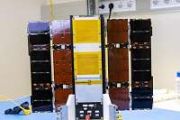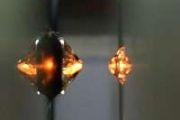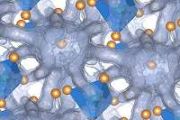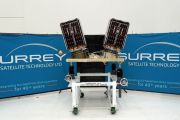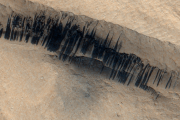
Copernical Team
Webb, Hubble telescopes combine to create most colorful view of universe
 Astronomers once again have combined the observational powers of NASA's James Webb Space Telescope and Hubble Space Telescope to create one of the most detailed and colorful portraits of the cosmos, just in time for the holiday season.
The new image, dubbed the Christmas Tree Galaxy Cluster by the research team that includes Texas A and M University astronomer Dr. Lifan Wang, combines visi
Astronomers once again have combined the observational powers of NASA's James Webb Space Telescope and Hubble Space Telescope to create one of the most detailed and colorful portraits of the cosmos, just in time for the holiday season.
The new image, dubbed the Christmas Tree Galaxy Cluster by the research team that includes Texas A and M University astronomer Dr. Lifan Wang, combines visi Scientists find 14 new transient objects in space by peering through the 'Christmas Tree Galaxy Cluster'
 An international team of scientists, led by University of Missouri's Haojing Yan, used NASA's James Webb Space Telescope (JWST) to discover 14 new transient objects during their time-lapse study of galaxy cluster MACS0416 - located about 4.3 billion light years from Earth - which they've dubbed as the "Christmas Tree Galaxy Cluster."
"Transients are objects in space, like individual stars,
An international team of scientists, led by University of Missouri's Haojing Yan, used NASA's James Webb Space Telescope (JWST) to discover 14 new transient objects during their time-lapse study of galaxy cluster MACS0416 - located about 4.3 billion light years from Earth - which they've dubbed as the "Christmas Tree Galaxy Cluster."
"Transients are objects in space, like individual stars, Extended habitability of exoplanets due to subglacial water
 Professor Amri Wandel, from Hebrew University of Jerusalem, has unveiled research that promises to redefine our comprehension of habitable exoplanets. In a recent study published in the Astronomical Journal, Professor Wandel introduces the concept of subglacial liquid water as a pivotal element in broadening the boundaries of the conventional Habitable Zone.
The classical Habitable Zone, o
Professor Amri Wandel, from Hebrew University of Jerusalem, has unveiled research that promises to redefine our comprehension of habitable exoplanets. In a recent study published in the Astronomical Journal, Professor Wandel introduces the concept of subglacial liquid water as a pivotal element in broadening the boundaries of the conventional Habitable Zone.
The classical Habitable Zone, o Juno finds Jupiter's winds penetrate in cylindrical layers
 Gravity data collected by NASA's Juno mission indicates Jupiter's atmospheric winds penetrate the planet in a cylindrical manner, parallel to its spin axis. A paper on the findings was recently published in the journal Nature Astronomy.
The violent nature of Jupiter's roiling atmosphere has long been a source of fascination for astronomers and planetary scientists, and Juno has had a rings
Gravity data collected by NASA's Juno mission indicates Jupiter's atmospheric winds penetrate the planet in a cylindrical manner, parallel to its spin axis. A paper on the findings was recently published in the journal Nature Astronomy.
The violent nature of Jupiter's roiling atmosphere has long been a source of fascination for astronomers and planetary scientists, and Juno has had a rings Bulgaria signs Artemis Accords at NASA Headquarters; Joins 31 Nations
 NASA Administrator Bill Nelson participated in a signing ceremony Thursday with Bulgaria's Milena Stoycheva, minister of innovation and growth, as her country became the 32nd nation to sign the Artemis Accords.
The Artemis Accords establish a practical set of principles to guide space exploration cooperation among nations, including those participating in NASA's Artemis program.
Also
NASA Administrator Bill Nelson participated in a signing ceremony Thursday with Bulgaria's Milena Stoycheva, minister of innovation and growth, as her country became the 32nd nation to sign the Artemis Accords.
The Artemis Accords establish a practical set of principles to guide space exploration cooperation among nations, including those participating in NASA's Artemis program.
Also Astronaut who led humanity's first mission around the Moon dead at 95
 Frank Borman, the NASA astronaut who led the 1968 Apollo 8 mission, the first human spaceflight to reach the Moon, has died at the age of 95, the US space agency said Thursday.
He passed away on November 7 in Billings, Montana.
"Today we remember one of NASA's best," said the agency's administrator Bill Nelson, in a statement.
"His lifelong love for aviation and exploration was only
Frank Borman, the NASA astronaut who led the 1968 Apollo 8 mission, the first human spaceflight to reach the Moon, has died at the age of 95, the US space agency said Thursday.
He passed away on November 7 in Billings, Montana.
"Today we remember one of NASA's best," said the agency's administrator Bill Nelson, in a statement.
"His lifelong love for aviation and exploration was only Glow in the visible range detected for the first time in the Martian night
 An international team led by scientists from the University of Liege has observed, for the first time in the visible range, a glow on the night side of the planet Mars. These new observations provide a better understanding of the dynamics of the upper atmosphere of the Red Planet and its variations throughout the year.
A scientific team led by researchers from the Laboratory for Planetary
An international team led by scientists from the University of Liege has observed, for the first time in the visible range, a glow on the night side of the planet Mars. These new observations provide a better understanding of the dynamics of the upper atmosphere of the Red Planet and its variations throughout the year.
A scientific team led by researchers from the Laboratory for Planetary University of Bern's LIMS Set to Uncover Moon's Mysteries in 2027
 In a landmark advancement for lunar science, the University of Bern, a beacon in space research since the Apollo era, is poised to make history once more with its latest instrument, LIMS (Laser Ablation Ionization Mass Spectrometer), set to land on the Moon by 2027. This venture is a part of NASA's Commercial Lunar Payload Services (CLPS) initiative, which integrates the prowess of American comp
In a landmark advancement for lunar science, the University of Bern, a beacon in space research since the Apollo era, is poised to make history once more with its latest instrument, LIMS (Laser Ablation Ionization Mass Spectrometer), set to land on the Moon by 2027. This venture is a part of NASA's Commercial Lunar Payload Services (CLPS) initiative, which integrates the prowess of American comp Lunar Mysteries Unraveled: Topographic Connection to Swirls Discovered
 In a groundbreaking study that challenges long-standing assumptions in lunar science, researchers have discovered a significant correlation between lunar swirls and the topography of the Moon's surface. This revelation, spearheaded by Senior Scientist John Weirich and his team at the Planetary Science Institute (PSI), may hold the key to deciphering the enigmatic history of lunar swirls.
L
In a groundbreaking study that challenges long-standing assumptions in lunar science, researchers have discovered a significant correlation between lunar swirls and the topography of the Moon's surface. This revelation, spearheaded by Senior Scientist John Weirich and his team at the Planetary Science Institute (PSI), may hold the key to deciphering the enigmatic history of lunar swirls.
L Hayabusa2 Unveils New Clues on Solar System's Beginnings from Asteroid Samples
 The Japan Aerospace Exploration Agency (JAXA)'s ambitious Hayabusa2 mission has once again brought to Earth not just asteroid samples but potential keys to unlock mysteries of our solar system's infancy. The mission, which daringly snagged samples from the asteroid Ryugu, has given scientists a pristine peek into the volatile and organic-rich materials that were present when the solar system was
The Japan Aerospace Exploration Agency (JAXA)'s ambitious Hayabusa2 mission has once again brought to Earth not just asteroid samples but potential keys to unlock mysteries of our solar system's infancy. The mission, which daringly snagged samples from the asteroid Ryugu, has given scientists a pristine peek into the volatile and organic-rich materials that were present when the solar system was 















